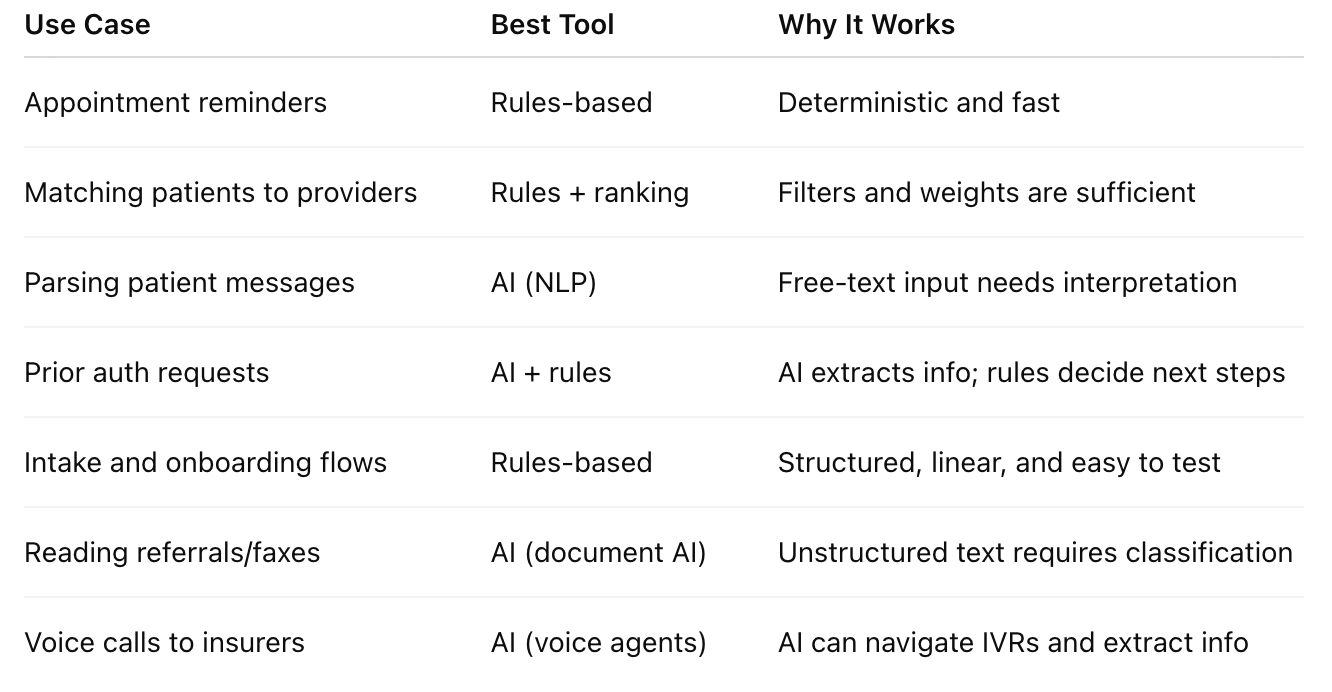When is AI Right for Health Care Providers?
Montana Scher
AI has taken center stage in healthcare innovation — ambient scribes, generative voice assistants, AI insurance bots, and LLM-powered decision support tools are becoming critical parts of healthcare provider workflows. As exciting as this progress is, not every workflow needs AI. In fact, in many cases, rules-based automation is faster, safer, and more intuitive — especially when you’re dealing with structured data or predictable processes.
The key is knowing when to use AI, when not to, and how to combine both in the right way.
⚙️ Rules-Based Automation: Fast, Deterministic, Reliable
Rules-based systems follow clearly defined logic:
If A happens, and B is true, then do C.
In healthcare operations, many high-value workflows fall squarely into this bucket. Examples include:
- Sending a patient a reminder to complete their forms 72 hours before an appointment
- Kicking off intake forms when a new patient books
- Routing a message to the right team based on keywords like “refill” or “billing”
- Inserting a cancellation slot back into the schedule and notifying the waitlist
These workflows don't require interpretation. They're about speed, reliability, and keeping humans in the loop when needed.
Bonus: Rules-based automation is transparent. It's easier to audit, troubleshoot, and explain — which matters in clinical and regulated settings.
🧠 Where AI Excels: Interpretation, Classification, Prediction
AI — especially large language models (LLMs) and machine learning — shines when the input is messy, unstructured, or ambiguous.
Use cases where AI adds real value:
- Ambient clinical documentation: Listen to a conversation, extract SOAP note content, and draft a chart note
- Calling insurers and navigating IVRs: AI voice agents can understand menus, talk to reps, and extract policy info that’s not available directly via APIs
- Extracting meaning from PDFs and faxes: AI can read a referral letter and pick out the urgency, diagnosis, and referring provider
- Understanding free-text patient messages: Classify intent (e.g. “I'm out of meds again and getting headaches”) → "refill request"
These are all areas where rules fall short — and AI helps turn chaos into structure.
⚡ Best of Both Worlds: Using AI Inside Rules-Based Workflows
The real power comes from combining the two: let rules-based automation orchestrate the flow, and use AI as a service at the right steps.
Here’s a real example from insurance verification:
- Trigger: A new patient books online
- Rules-Based Workflow:
- Send them a form to collect insurance info
- When the form is submitted, check the payer
- If it's a payer that doesn’t support automated eligibility checks →
- AI Step: Trigger a voice AI agent to call the insurer and retrieve benefits info
- If it’s a payer that does support automated benefits checks →
- Configure request to payer to get benefits info specific to services
- Rules Continue:
- Insert results into the EHR
- If no info is returned, create a task for a human to follow up
AI handles the fuzzy step of interpreting voice responses from a call, rules control everything else — the when, how, and what happens next.
👎 When AI Is Overkill
Some workflows sound like they should be powered by AI — but actually work better with rules.
Take patient scheduling:
It’s tempting to imagine an AI chatbot that handles scheduling via text or voice. But in reality, most patients just want a clear calendar UI with available times. Rules-based scheduling (filtered by provider, insurance, state, etc.) is often simpler and more effective.
AI can add value in edge cases (e.g., dynamically ranking contacts on a waitlist when a slot opens), but the core workflow works great without it.
Same goes for patient matching — rules around provider specialty, insurance, and location cover the majority of use cases. Unless you’re doing something like parsing free-text preferences or matching based on historical outcomes, AI isn’t necessary.
Using AI for these cases requires a strong data pipeline, lots of past data, and a risk of error that likely not worth it when the rules-based approach can get you 98% of the way there.
✅ Takeaways: Examples of When to Use What

🚀 The Bottom Line
AI isn’t the answer to everything — but used wisely, it can help healthcare teams do more with less. The best systems use rules to define structure and guardrails, and AI to unlock meaning from the messy middle.
Outpatient practices don’t need to choose one or the other. By embedding AI smartly within automation workflows, you can build systems that are both intelligent and dependable — and, most importantly, designed for how real people work.